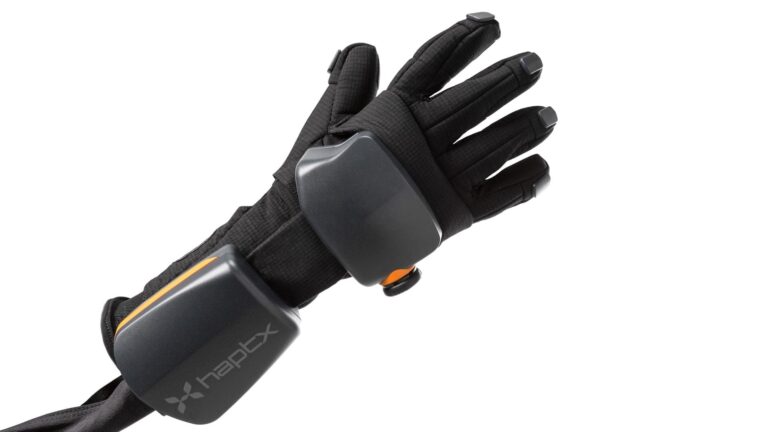
Imagine feeling the rush of a waterfall in virtual reality or the weight of a digital tool in your hand. That’s possible with VR haptics. Virtual reality is powering innovation in haptic technology and creating incredible new ways to use it in entertainment, education, and the workplace.
Evolution of Haptic Technology
Haptic technology has a long history in the video game and simulation industry. The first mainstream appearance of haptics in gaming was the Rumble Pak accessory for the Nintendo 64, originally released in 1997. It provided simple vibration-based haptics in compatible games.
Afterward, vibration became a standard feature in game controllers, starting with the original DualShock controller for the PlayStation. Haptics was an instant hit in gaming. They allowed players to feel like they were firing a weapon or flying a jet. Basic vibration was only the beginning of haptic technology, though.
In 2017, Nintendo released one of the most popular game consoles in history: the Switch. It included HD rumble, a new take on vibration haptics. It has more nuanced responses, like buzzing and shaking. The PlayStation 5 introduced DualSense in 2022, a similar next-generation type of vibration haptics.
Virtual reality skyrocketed in popularity during the 2010s, partly due to the Google Cardboard project, which made VR much more accessible. The immersive nature of VR opened up new opportunities in haptic technology. Haptic controllers are a standard accessory for today’s leading headsets, such as the Meta Quest 2.
Third-party developers are beginning to explore an exciting new niche of haptic tech: gloves. They allow users to experience highly realistic touch sensations in virtual reality. The whole-hand platform also makes haptics more life-like than controller vibrations. Developers have released several prototypes and early models for the Meta Quest 2 over the past few years.
Types of VR Haptic Feedback
There are two main types of haptic feedback in VR: kinesthetic and tactile. Kinesthetic haptics are the most common, simulating physical forces like pressure or vibration. Tactile haptics simulate textures. They’re more technologically challenging to develop and thus remain less common.
Haptic technology is either active or passive. Kinesthetic haptics are nearly always active, meaning the user must perform a physical action to activate the feedback. Passive haptics start on their own. They’re more likely to be tactile experiences, such as simulated water running over a user’s hand.
Passive and active haptics appear in various technologies, including controllers, gloves, and vests. The most common example is the basic kinesthetic active haptics in most video game controllers.
Applications for Haptics
There are countless amazing applications for haptics in virtual reality, from improved immersion to educational uses to job training. Of course, haptic gloves from the likes of Haptx as well as vests make VR games more thrilling and fun, but the applications go beyond entertainment.
For example, haptics open up new possibilities in educational VR. Students can use haptic gloves in virtual reality science labs where they can actually hold and touch the digital lab equipment. Teachers can include a wider variety of activities in their labs thanks to the safety of the simulated environment.
VR has proven effective in education, particularly for virtual field trips and learning games. Cybersecurity risks are the only drawback of increasing its use in schools. The education sector is a top target for hackers today. In May 2022, 82% of cyberattacks targeted educational institutions. Schools will need more robust cybersecurity to adopt more VR tools and apps safely.
VR haptics also have immense potential in job training for dangerous careers like construction and emergency response. These fields have some of the highest injury rates in the world. Education is crucial for preventing accidents but poses risks of its own.
Employees can receive immersive, life-like training with next-gen VR haptic technologies like gloves and vests in a risk-free environment. Research shows haptic feedback increases the effectiveness of VR safety training programs. It allows trainees to learn what dangerous situations feel like, which helps improve retention and prevent risky behaviors.
Employees can also use VR haptics on the job in some fields. People could perform dangerous tasks remotely using VR-controlled robotic equipment. One real-world example is a remote forklift driving station that allows employees to operate machinery from the safety of a desk.
In the future, employees could use remote operation systems like this in virtual reality. Developers could program haptic gloves to provide life-like steering wheel feedback and safety-related vibrations.
Future of Haptic Technology in VR
Exciting things are ahead for VR haptic technology. Gloves are widely available today but remain bulky and expensive. One of the most significant advancements is more affordable haptic gloves for popular headsets like the Meta Quest 2.
Innovation in haptic vest tech is also likely. The foundations of this tech exist today, so it’s only a matter of time before they hit the mainstream market. The biggest challenge is support from games. Gloves are easier for developers to integrate, but vests may take more development to fully utilize in VR apps.
Changes in VR hand controls will shake up the haptics market. In 2023, Apple announced its long-awaited mixed-reality headset, the Apple Vision Pro. Unlike every leading headset on the market, the Vision Pro relies entirely on hand gestures and doesn’t come with controllers.
That may sound like bad news for haptics, but it might be the key to innovating the market. The Vision Pro has the most precise hand tracking ever released, meaning there could be massive potential for haptic glove technology in Vision Pro apps and games. Advanced hand tracking bypasses conventional controllers to utilize the full range of hand motions in VR. It will be exciting to see how haptic glove tech advances after the Vision Pro hits the market.
Unlocking the Potential of VR Haptics
Haptic technology is the key to designing fully immersive virtual reality experiences. VR has powered innovation in haptic tech over recent years. In the future, haptics will create new ways to use virtual reality in everything from education to the workplace.
 April Miller is a senior writer at ReHack Magazine and editorial contributor at AR Insider. She specializes in VR/AR, IoT, and business technology. See her work here and follow her @rehackmagazine.
April Miller is a senior writer at ReHack Magazine and editorial contributor at AR Insider. She specializes in VR/AR, IoT, and business technology. See her work here and follow her @rehackmagazine.






